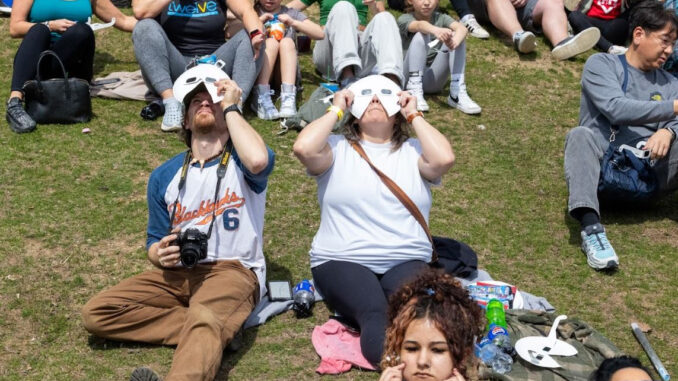
Kaitlyn Hughes | Staff Writer
For Matt Bottegal, viewing the total solar eclipse in a public space was a no-brainer.
“It’s so much more fun to experience things with other people,” Bottegal said. “I want to see [my son’s] experience, but it’s interesting to see other people.”
Bottegal brought his 12-year-old son, Ricky Bottegal, and father, Paul Bottegal, to the Carnegie Science Center for the one-in-a-lifetime occurrence.
Along with the family, about 1,000 people gathered on the museum’s Riverview Terrace Monday afternoon to witness the rare event.
The phenomenon was a chance to connect with science and other people.
Heads tilted at the sky and a countdown began as the Solar Eclipse reached its peak in Pittsburgh at 3:17 p.m.
Bottegal said this event was comparable to a firework show being able to hear everyone’s ‘Oohs’ and ‘Aahs’ as they witnessed the eclipse.
Children cheered and pointed to the sky as the atmosphere darkened and grew cooler.
“It was cool to watch it move,” said Myla Hoover.
Hoover’s mom, Abbey Fickley, brought her and her friend, Willow Stegena, to experience the eclipse.
“It definitely made them excited,” Fickley said. “As an adult or a mom, the experience of getting to show children this, that’s all really cool. Introducing children to real life earthly things.”
A solar eclipse occurs when the moon crosses between Earth and the sun, therefore casting a shadow onto specific parts of the globe.
The path of totality ran through Mexico, the United States and Canada, stretching from Texas to Maine. Cities including San Antonio, Indianapolis, Cleveland and Rochester, were under darkness during max totality.
Although Pittsburgh only witnessed a partial eclipse at 97%, it was the only time the U.S. will be in the path of totality until 2044.
Total eclipses occur every one to two years, according to director of theater experiences, Amanda Iwaniec.
“Earth is made mostly of water, so many times one of these total solar eclipses would happen over the sea or in different parts of the world,” Iwaniec said. “A total eclipse could happen in the same area on an average of every 400 years.”
Iwaniec explained that the next total solar eclipse will occur in Aug. 2027 and will be visible in Egypt.
According to Iwaniec, the eclipse was an asset to the overall goal of the Carnegie Science Center – to spark interest in learning.
“What’s really fun about the Eclipse is we are able to do some tactile, hands-on science,” Iwaniec said. “We will be able to take and pick apart each little bit of science and help kids and families and adults understand what is really happening and why this is so important.”
Attendees were able to take part in a multitude of activities throughout the day including a solar eclipse programming, lessons on space chemistry and the Live NASA Feed.
Outside where the eclipse viewing occurred, children created masks and cases for their solar glasses, witnessed a demonstration of the eclipse and made spin art to represent nebula.
Planetarium presenter Nate Kroboth showed attendees the different equipment that can be used to view the eclipse.
The first was a SunSpotter.
“[The Sun] goes through different lenses and mirrors, so if you don’t have solar glasses you can point this lens at the solar eclipse,” Kroboth said. “The sunlight will bounce through the lens and also veneers and a projected image will show up on this piece of paper right here. As the Moon passes in front of the Sun, you will see the projection of the solar eclipse on the piece of paper.”
Kroboth demonstrated how a normal telescope can become solar-eclipse-safe by using a funnel and solar filter in place of the eyepiece. A projected image of the eclipse appears on the funnel for viewers to “watch it like we’re watching a movie.”
Bottegal recognized the importance of finding lighthearted ways to incorporate science into children’s lives.
“We need to guide kids into the things that they need to learn, and if we make it fun, make science fun, then people are interested in it,” Bottegal said. “Then more developments happen.”
Bottegal’s father, Paul Bottegal, agreed with him saying there is one question everyone asks themselves, “How the heck does that thing work?”
This question is why having opportunities for children surrounding scientific events is important to Bottegal. He said invoking this question within kids helps them to better understand their environment and be successful in future endeavors.
“That’s a question that should really be on the front of your mind at all times,” Bottegal said.
While people at the Science Center were viewing the eclipse, members of Duquesne’s community also enjoyed the scientific phenomena.
Associate professor of physics Simonetta Frittelli brought 200 glasses to campus which allowed students, faculty and staff to participate in the eclipse.
Frittelli said viewing an eclipse was transformative for the students on campus. It helped people remember that there is a world out there that humans have no control over.
“Seeing the Sun missing a piece was impactful for them,” Frittelli said. “To experience an eclipse is something you don’t forget.”
Since the next eclipse in the United States is not for another 20 years, many are wondering what to do with their solar glasses.
According to the Oklahoman, two organizations will be collecting the glasses for donation.
Astronomers Without Borders will send the contributions to underserved communities. Warby Parker locations will be collecting the glasses.
Eclipse Glasses USA will send their donations to students in Latin America so they can participate in the annular eclipse that will occur in Oct. 2024. The glasses can be sent to: Eclipse Glasses USA, LLC, PO BOX 50571, Provo, UT 84605.
To be donated the glasses must be undamaged without tears or scratches.

